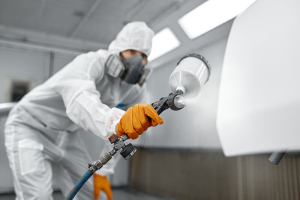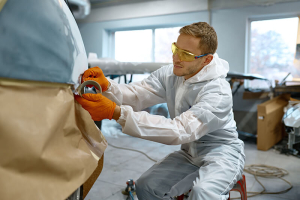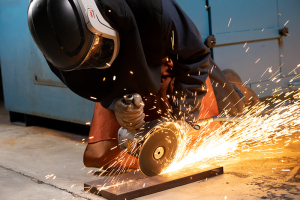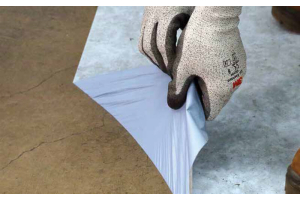Learn How To Choose The Correct Abrasive For Your Application
Learn How To Choose The Correct Abrasive For Your Application
C.W. Hayden Co. How To Series
Hi, I'm Chris Hayden from CW Hayden Company. We're industrial and Marine specialist based in Auburn, Maine. And we love Abrasives.
Today, I'd like to talk a little bit about the basics of choosing an abrasive. There's a lot of different options, as you can see. It all depends on how you want to set it up, what your speed requirements are, how big your shop is, how big your budget is, there are lots of different variables. You can break it down into three different steps.
First of all, you want to select your substrate. That's probably already done for you. You're sanding on wood, metal, glass, something like that. Next thing to do is choose your application. Are you going to be sanding by hand with a sanding block or a sheet of paper stuck on a little hand block, or are you going to be using a wide belt sander or something in between?
After you've decided what kind of equipment you want to use or use your own power, you can then move on to selecting your abrasive. And there's a lot of different choices. It usually comes down to one really basic tenet, and that is look in the trash and see what the abrasive looks like when you're done. If you've already been doing this for a while, if the abrasive is loaded up chances are you need to go to a less expensive, abrasive, or use something that's pretty inexpensive because you're not getting the full life out of it.

If it's worn down or shelled or torn up or something like that, you can probably get better economy by going to something that's a little more expensive but also longer lasting. We have lots of different choices. If you want to try cloth discs and things like that. We have lots of different films and all kinds of different choices that you can make and you dial it in from there.
What I'd like to do first is just kind of break it down by the actual substrates that we commonly see in industrial applications. The first being, we see a lot of metal, people are grinding on metal, sanding metal, buffing it out to a mirror finish in some cases, or just getting it ready for painting. So if you're just getting it ready for painting or maybe you just want to grind a weld down, the old type 27 wheel or cut off wheel or something like that is a good way to start.
There are some new ones out there. I've got ceramic blends that are extremely efficient. They cut so well, they'll actually cut little curls of steel like you have with a drill bit and they'll be throwing them all over the place.
If you're going to be taking it beyond that and finishing those grind marks. Then you need to get into something like a die grinder. If it's going to be a small area, hitting it with a roll lock disk, that might be a ceramic in this case or a scotch-brite like this or rip off a coating that's on there first with something like that, that's very, very coarse. These are very handy because they're lightweight, they're powerful. They do take a lot of air, but they can get a lot of work done in a small area and tight areas, quickly.

If you need to go a little bit bigger, you can get a grinder or a polisher or a bigger sander that's running eight inch even up to 11 inch discs for big, big areas. A lot heavier, a lot more dust flying around with that kind of thing. It also takes a lot of different kinds of abrasives. We would typically put on that something that's a lot heavier, like an F weight paper or something that's even board-ier or like a cloth. Just because they tend to wear out pretty quickly and they shred on the edges like this one has a little bit right there.
It's important to match your abrasive to the application so that you get get the best kind of economy. The other machines that we have, if you don't want to have a circular sanding pattern or you're just trying to fair something up and smooth it out, we have these oscillating Sander's like this. These are gear driven sanders, they run on a sun gear inside. Very effective at removing softer materials like bondo from large surfaces in a hurry, flaring things out flat so you can then hit it with an orbital sander and pneumatic with a dust free system or electric. The new electrics are super. You can hook this up to a vacuum and collect the dust as you're going and that will collect the sanding dust. Especially important if you're standing on stainless steel. From there you would take it to a buffer and polish it up if you needed to or paint it.
Proper abrasive choices for most metalworking applications are ceramic or in some cases, zirconia. There is still some zirconia around, aluminum zirconia. It's an older style mineral that's pretty sharp, pretty hard, pretty durable. Not as good as the new ceramics that are out there, the 3M Cubitron II's and things like that. But still, it's a good choice because it's economical.
Next kind of substrate we see a lot of is wood. Still plenty of people that are sanding on wood. This is a wood sanding belt. You'd run it through a timesaver or a wide belt machine. That one right there is a 60 grit. I don't know if you'd really want to be doing much with 60 Grit on wood, but they go all the way up to 150, 180 grit, and you can come out with a pretty fine finish running it through instead of a planer, you run it through an abrasive planer, not typical in small shops, but still plenty of them around.

There are still a lot of people that will sand by hand, either a block where you put a piece of paper on there and you can actually hook that one to a vacuum to collect the dust or just a regular block like that, that takes stick it paper that sticks on there or even a sanding sponge. These are conformable, they're soft, they're squishy. They don't last terribly long, but they do a pretty good job most of the time.
And again, we do see a lot of random orbital sanders going into woodworking because of their versatility, their ability to sand aggressively on wood and also fine finish because we have abrasives that go all the way up to and beyond 1200 grit, starting at 60 grit and in some cases even 40 grit, not the greatest choice for a random orbital sander, 40 grit, but if you start at 60 or 80 grit, you can get a lot done.
And then you'd finish off a top coat or something like that where you might want to polish it again with the finer grades for standing out paint or varnish or something like that. Or Lacquers 400, 800, 1200 grit, again with a random orbital sander that'll make it quick.
The next kind of substrate we see a lot of, especially in New England here, is composites. A lot of people building things out of fiberglass like boats and spars and things related to marine applications. Again, it's almost kind of a combination of the two where we see a lot of people that are sanding heavily with big machines like this on the outsides, trying to fair big surfaces down. They may even use something like this for grinding down fillers where they are trying to make something a lot smoother. And then they typically will go to a random orbital sander to do, their final finish work.
And again, they can start at 40 grit and work all the way up to 1500 before they start buffing to a high gloss on a gel coat finish.
We do have other combinations in here that are kind of variable, so it's important that you work with your rep to figure out what the proper abrasive would be. There's too many choices to go into right now, but suffice it to say that if you have an application, we have an abrasive.
I thank you for your time and I hope to hear from you soon.









